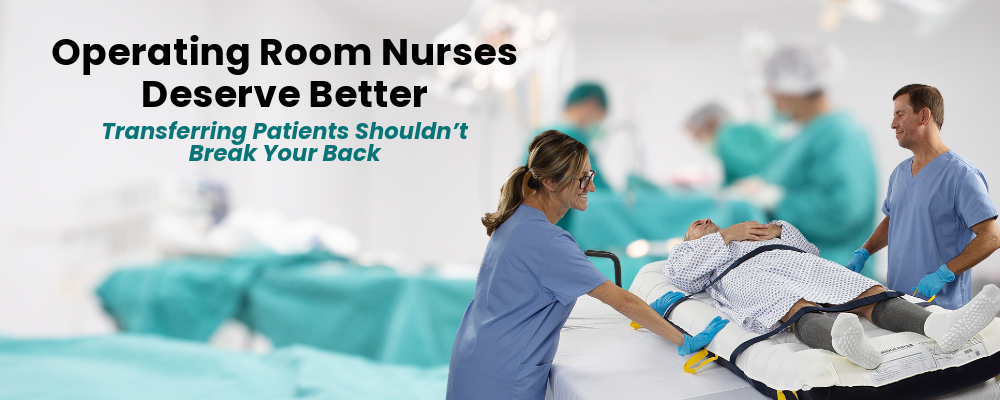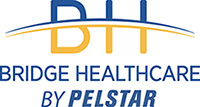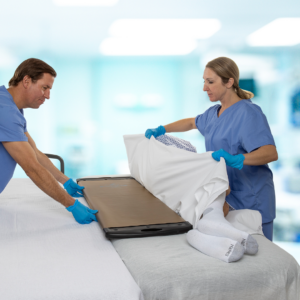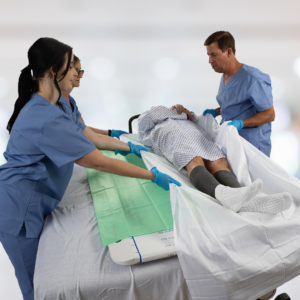
In the O.R. ~ My Back Hurts!
On three… 1… 2… 3… Phew!!! Sound familiar? What does that sound like?
You guessed it: transferring patients from the OR table to the stretcher or bed! Sometimes it’s easy, but more often, it’s dreadful. As our population gets heavier, your job gets harder.
Every patient—excluding those undergoing surgery in specialty chairs or stretchers—must be transferred post-surgery from the OR table. Doing this repeatedly puts you in the highest risk category for injury. It could be your back, your shoulder, or both! Approximately 38% of nursing staff experience back injuries or back pain during their careers.
What We Heard from You
We recently attended an educational conference for operating room nurses and we asked one question that left us stunned:
How do you transfer patients after surgery from the OR table to the stretcher or bed?
While some nurses worked for organizations that prioritized their safety, here are the most common answers we heard:
- “Our muscles.”
- “Our backs.”
- “I hate to say this, but we use garbage bags if the patients are heavy.”
- “Staff.”
Some just raised their arms to flex their muscles. Others exchanged looks that screamed, “This is a sore subject.” A few mentioned plastic slide boards or roller boards, but these are like using a typewriter for your social media posts: outdated and inefficient.
A Heavy Burden
Let’s put this in perspective. During your time off, what’s the heaviest object you push or pull? A refrigerator? A dresser? A washing machine? Would you attempt to move these without help? Likely not. You’d use a dolly or other mechanical aid because the risk of injury is too high. Yet, in your professional life, transferring a 300- or 400-pound patient often comes down to brute strength.
This is not okay. You are a valuable asset to the hospital. Protecting you should be a top priority. Your job should be safer and easier, not the opposite.
A Safer Way Forward: Tools for Safe Transfers
The good news? You don’t have to rely on outdated methods like manual lifting or basic slide boards. There are assistive devices specifically designed to make patient transfers safer for you and the patient. These tools significantly reduce the effort required, minimizing your risk of injury and ensuring a smooth transfer every time.
Why Now Is the Time to Act
If protecting yourself and your team from these risks hasn’t been a priority, now is the time to change that. Injuries don’t just happen; they are often the result of preventable situations.
- Statistics tell the story: According to the Bureau of Labor Statistics, nursing assistants and RNs are among the top professions at risk for musculoskeletal injuries, with over 35,000 cases annually related to patient handling.
- Cumulative damage: The wear and tear on your body compounds over time, leading to chronic pain, reduced mobility, and, in some cases, early retirement.
Don’t wait until it’s too late. Your safety—and that of your team—is far too important.
Let’s Find the Right Solution Together
At Bridge Healthcare, we’ve spent 25 years advocating for safe patient handling, particularly for healthcare professionals like you. We understand the challenges you face and are here to help.
If you’re ready to eliminate the risk from patient transfers, CLICK HERE. We’ll introduce you to three assistive devices tailored to your needs, ensuring you and your team stay injury-free while providing exceptional patient care.
You Deserve Better
Your health and well-being are just as important as your patients’. It’s time to prioritize your safety, because a safer team means better outcomes for everyone involved.
https://aacnjournals.org/ajcconline/article/12/5/400/217/Nurses-and-Preventable-Back-Injuries


